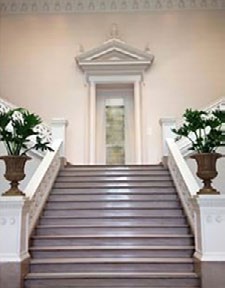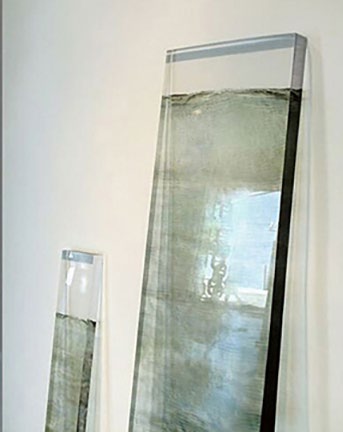New Orleans Museum of Art
New Orleans, LA
BY TERRINGTON CALÁS
New Orleans Art Review | Fall 2015
[…] “TEN YEARS GONE,” was curated by NOMA’s Russell Lord and slated to signal the 10th anniversary of Hurricane Katrina. It takes on a capacious, four-part theme: “time, memory, loss and transformation.” And the exhibition, as Lord puts it, sought “to situate the significance of the past decade within a larger context of human endeavor and life experience.” This may seem an unwieldy task — and doubly so when one considers that only six artists were engaged. But then, for a Katrina memorialization, something ambitious was certainly necessary and welcome. So was the declared attempt to subdue the obvious, to avoid “images of destruction or ruin that so often follow in the wake of tragedy.”
And yet, the final display we see — organized and installed with consummate finesse — is something of a jolt for many viewers. The broad theme, it might be said, permitted a selection that, with two exceptions, virtually sidesteps Katrina itself. My view on this is ambivalent. The exhibition’s concept is solid, pertinent, and it brings together some truly moving works of art — an occasion much needed in an art world lately freighted with every manner of the trivial. On the other hand, it is difficult to jettison the impact of personal experience on our commerce with this, or any, exhibition. To quote one colleague, the oblique nature of the project was “a superlative idea, at least from a certain vantage; that is to say, from the vantage of someone who did not actually endure the reality of Katrina and the levee failures.” I note this because the larger audience for “Ten Years Gone” must be taken into account. That audience, in great measure, has an emotionally charged relationship to the anniversary. For some, “oblique,” in this circumstance, will signify detachment. Such an impression, unfortunately, might generate a mere glance at what may be one of NOMA’s most powerful shows in memory.
This high estimation relates to the richness and force of certain works Lord has selected. Besides Saucedo’s lyrical suite, the other glory of “Ten Years Gone” is Dawn DeDeaux’s stately Water Markers, a series of plank-like, acrylic sculptures encased with images of clear water. They lean against the wall in various spaces throughout the museum, at times juxtaposed with objects in the permanent collection.
At first, they suggest a transparent take on the classic painting-sculpture hybrids of John McCracken — those propped slabs, lustrously monochromed, that lent a nonchalance to the minimalist movement. (A fine example of these was, for some years, in the lobby at K&B Plaza). But DeDeaux’s Water Markers are, at core, a patent departure from the orthodoxies of old-line minimalism, most notably its firm literalness. Her topic here is the life-world, and human exigency in the life-world — and, specifically, the appalling consequences of the post-storm floods of 2005.
She reflects upon this with a poised and all but diffident body of works. No heated sentiment. No lamentation. Instead, you detect a muted yet sustained intensity, a rapt gaze upon nature in the larger sense. And her final rendering is something bordering on the exquisite, something treasurable. The sheer elegance of the sculptures is almost startling. You hesitate to savor it. Is this the surface of grave content? What you see is an aristocratic grace that brings to mind Ellsworth Kelly’s spare, nature-revering abstractions — very different works with a similar tone. It is a grace without rhetoric — unvaunted, but Olympian in its reserve. This is form stripped clean of ornament. You feel the bliss of beauty, but not its easy decline into vulgarity.
What really matters here, of course, is the employ of such beauty as it touches on natural phenomena. In Kelly’s art, it has long been a question of immaculate images culled from pondered observation. For him, nature — along with some of the built world — provides a matrix for formalist aesthetic invention. His preoccupation, verging on obsession, is optical discernment. He offers an utterly purified world.
DeDeaux, on the other hand, seems less occupied with the look of things. In her Water Markers, elegant form is a supportive mechanism; it serves as a means of presentation. The approach, in fact, feels almost anti-aesthetic. What seizes you is the foursquare directness of method — reductive objects casually submitted, as if by chance. But that method is essential. It compels your interest. And, in a sense, it evinces DeDeaux’s aspiration beyond formal questions. What she advances, in lieu, is a measured pursuit that takes the floods as a springboard. Her objective, it would seem, is a contemplation of the dense reality of nature — its mystery, its fields of force, its portents, its human conjunctions.
For this theme, one might imagine a plight-laden image, an image fingering out to the dire effects of nature’s power and, in fact, laying such effects unapologetically before us. I am thinking here of much of the art we saw in the months following Katrina. To be sure, some of those images will haunt us forever. Others will linger as invaluable documents.
But the weight of this project — such a concentrated attempt at penetrating nature — can be better served by a kind of religious art; and perhaps the most affecting religious art is a an exceedingly discreet one. (Consider, for example, from the early 19th century, Friedrich’s famous monk, diminutive and immobile before the infinite.) Thus the ceremonial, exalted tenor of a work like DeDeaux’s Rushed in Near Ten, installed shrine-like at the top of the museum’s great staircase. All you see is a segment of captured nature, a water image set apart, vitrined. But the image is immensely suggestive. It is beatified by its manner of display, by its unique location; vivified by light, constantly altered by light. Like all the pieces in the series, the sculpture has a complex function. It exhibits a pictorial façade and, via transparency, “projects” a shimmering, “metaphysical” twin. And further, the consequent spectacle intimates nature’s force — everything from the ripples in a pond to a monumental surge. The mind-pictures you garner are endless. And notions of a transcendent presence — of the deity — are impossible to avoid.

Dawn DeDeaux: Rushed in Near Ten from Water Markers, 2006-2015. Installation, New Orleans Museum of Art.
Such notions call to mind the long tradition of the Romantic landscape. In a singular way, the Water Markers appear to honor it. We think of that tradition, at its headiest moments, in terms of an artist’s encounter with “the sublime” — ego-eclipsing awe in the face of nature. This was a deeply emotional mode and, in key works, theology overbore aesthetics. Its sentiment is echoed in William James’s famous text: “… the will to assert ourselves … has been displaced by a willingness to close our mouths and be nothing in the floods and waterspouts of God.” In the late-modern era, such obeisance seems quaint. Even Land Art, the 1960s and 70s heir to the tradition, was only meagerly theological. Pivotal artists of that movement, chiefly Robert Smithson and Walter De Maria, sought a kind of primeval spirituality, but there was a certain impudence in their attitude. They looked upon nature as a medium — something to manipulate, to transform and invade, symbolically to ravish. In various guises, that posture persists today.
DeDeaux’s view, as I say, is singular. And a part of this is the way she touches so cannily on art history, all the while assaying a contemporary moment. You sense, especially, a presiding aspect of the Romantic; to wit, the Doric grandeur of the Water Markers. They present themselves, metaphorically, as the lifeworld in excelsis. But then, there is also evidence of the savvy modernist with an envie for ancient culture — something manifest in the serene, elemental poetics of these sculptures. As a result, you fancy a vague accord with Land Art’s primitive forms, but certainly not with its nature-bending hauteur. Indeed, the natural imagery you see is presented factually, unsullied — water simply reproduced. More important, an air of deference suffuses DeDeaux’s works. Positioned as they are, they attain a sacramental air, as if one should stand mute before them. And yet, they are hardly an attempt at “the sublime redux,” nothing so dramatic. This is a meditated venture, not an impassioned one.
DeDeaux’s aesthetic skirmish with the past serves her well. Straight off, it provides an appealing conceptual richness. But signally, it clarifies her distinctiveness. Although I see her mainspring as largely pantheistic — or broadly religious — her unique strategy plays a disarming role. I’m thinking here of her intimacy of vision. She tackles a vast subject by diminishing it. You see this in two ways. On the one hand, with a sly quaintness, she employs the Water Markers as direct signifiers of matter-of-fact detail. Each panel indicates an actual water level that was witnessed and declared by a homeowner in poststorm New Orleans. Hence the titles: Topped out at eight, and Not too bad…almost four, and the like. And this matter-of-fact gambit leads to the true, more evocative intimacy of her project.

Dawn DeDeaux: Water Markers (detail), 2006-2015. Installation, New Orleans Museum of Art.
This relates to DeDeaux’s choice of imagery and how she maneuvers it. The sculptures take one of the particulars of the natural world — water— and enshrine it. By dint of context and frontality, this synoptic image becomes less a depiction than a real presence in the room — with you. Its nearness and implied factuality stop the eye, compel you to take a long, considered look. And every possible inference comes to mind. Among them, of course, is some sense of the sublime — the sublime with its implication of formidable nature. But DeDeaux’s intimate view seems to refute the very idea. By closing in the way she does — a kind of discreet scrutiny — she impels you to observe, behind glass, the exquisite otherness of nature. A strangeness to be pondered, not feared. You grasp also a surpassing yet delicate beauty, and you come away persuaded of the overall benignity of the life-world. These sculptures are sleek, condensed sonnets of hope.
This is an excerpt. The article may be read in full here.
